EAL/D Teaching Plan: Strategies for English as Additional Language
VerifiedAdded on 2022/10/02
|6
|1578
|218
Report
AI Summary
This report provides an in-depth analysis of an EAL/D (English as an Additional Language or Dialect) teaching plan, focusing on strategies for supporting students from diverse linguistic and cultural backgrounds. The report begins by highlighting the importance of EAL/D approaches in culturally and linguistically diverse countries like Australia, where English is the primary medium of instruction. It then defines EAL/D students and discusses the challenges they face, illustrated through a case study of a student named Sara. The report outlines the characteristics of effective EAL/D approaches, including the materials, learning modes, and learning aspects involved. It details a step-by-step plan for integrating Sara into an English-speaking curriculum, including strategies for language use, academic language proficiency, and time management. The plan emphasizes incorporating enriched content and skills, such as writing and communication, to enhance Sara's language development and social integration. The report concludes by emphasizing the importance of providing guidance, support, and resources to facilitate EAL/D students' understanding of the English language and its cultural context, ultimately helping them succeed in the dominant discourse. References to relevant literature are also provided.
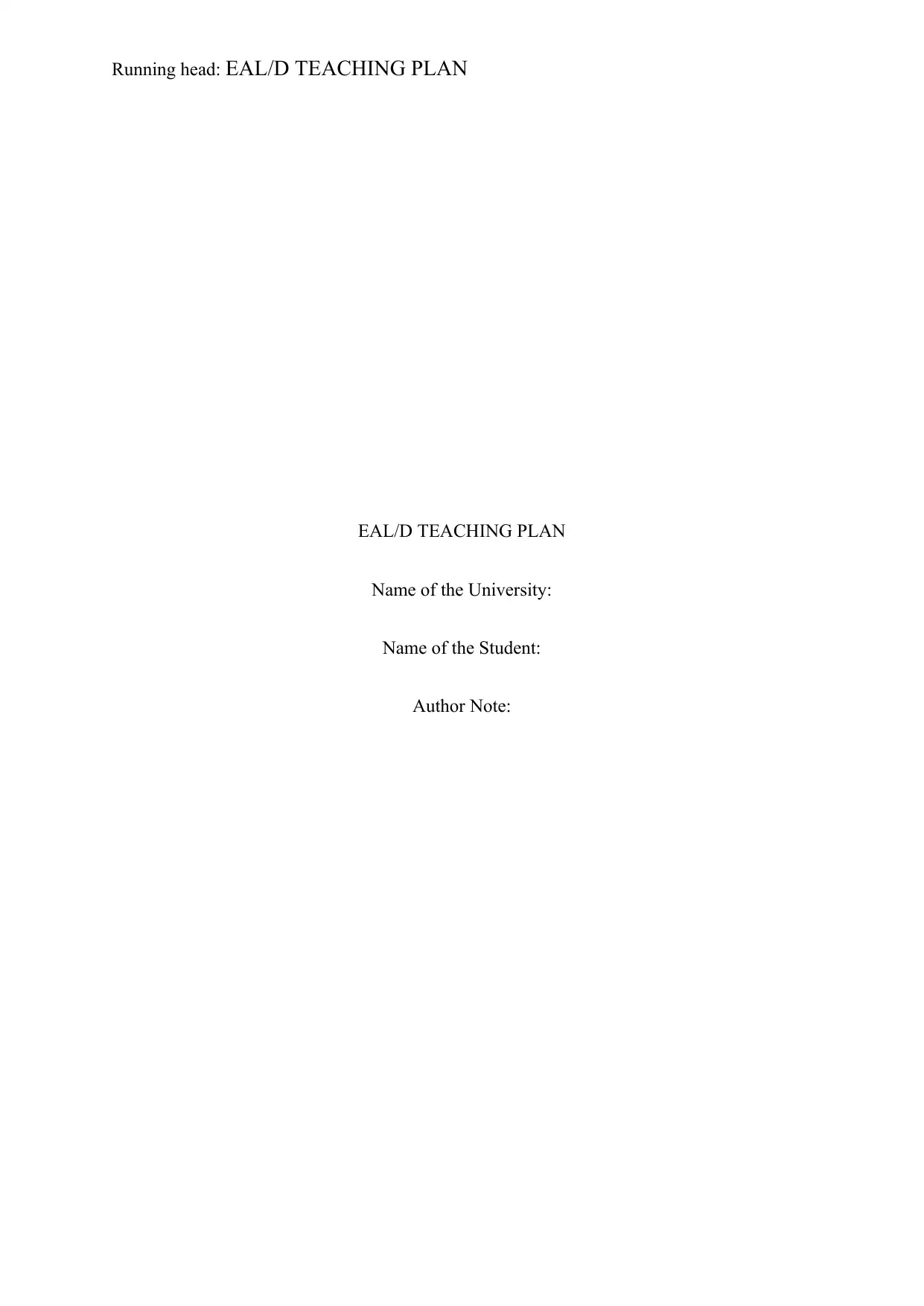
Running head: EAL/D TEACHING PLAN
EAL/D TEACHING PLAN
Name of the University:
Name of the Student:
Author Note:
EAL/D TEACHING PLAN
Name of the University:
Name of the Student:
Author Note:
Paraphrase This Document
Need a fresh take? Get an instant paraphrase of this document with our AI Paraphraser
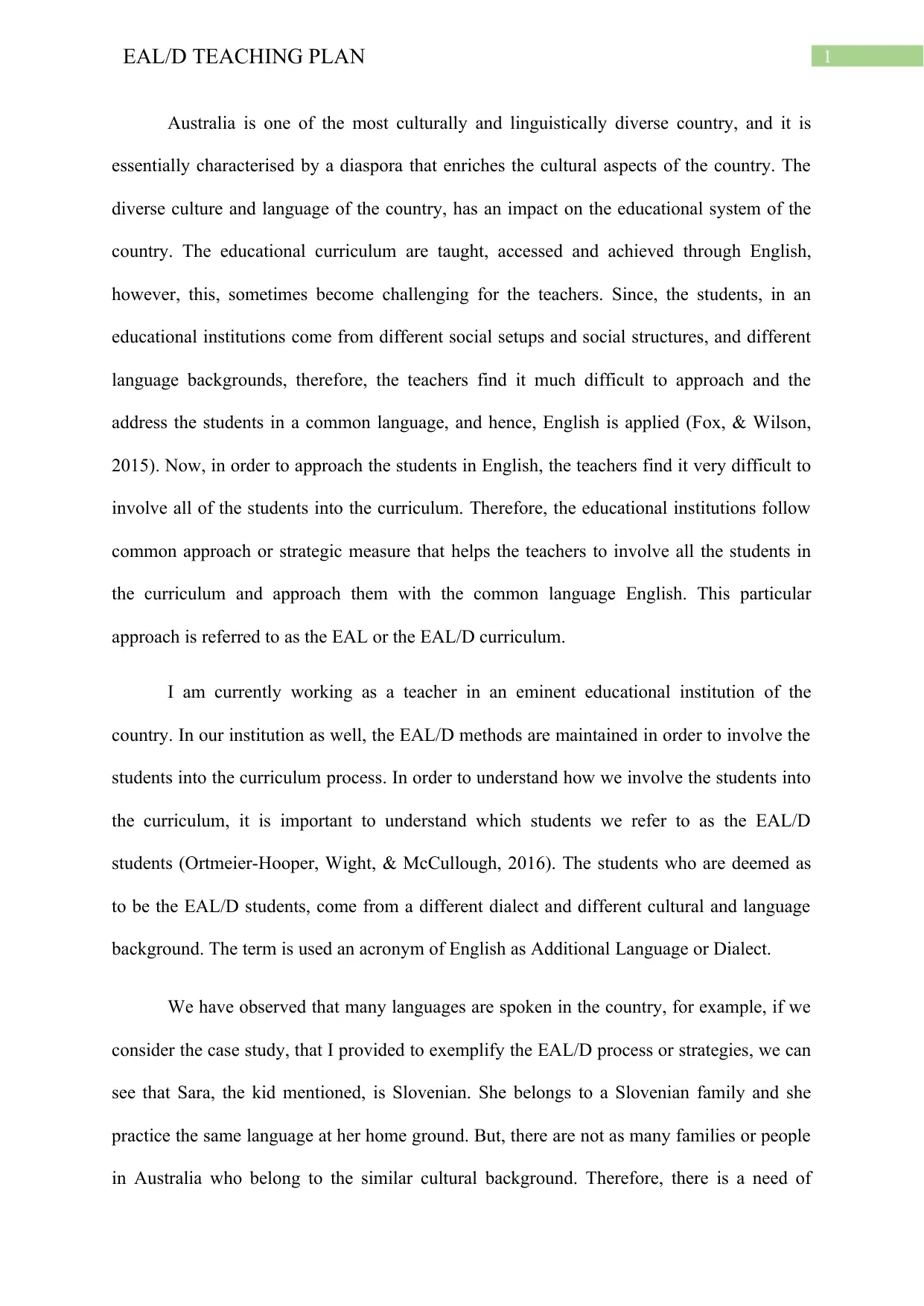
1EAL/D TEACHING PLAN
Australia is one of the most culturally and linguistically diverse country, and it is
essentially characterised by a diaspora that enriches the cultural aspects of the country. The
diverse culture and language of the country, has an impact on the educational system of the
country. The educational curriculum are taught, accessed and achieved through English,
however, this, sometimes become challenging for the teachers. Since, the students, in an
educational institutions come from different social setups and social structures, and different
language backgrounds, therefore, the teachers find it much difficult to approach and the
address the students in a common language, and hence, English is applied (Fox, & Wilson,
2015). Now, in order to approach the students in English, the teachers find it very difficult to
involve all of the students into the curriculum. Therefore, the educational institutions follow
common approach or strategic measure that helps the teachers to involve all the students in
the curriculum and approach them with the common language English. This particular
approach is referred to as the EAL or the EAL/D curriculum.
I am currently working as a teacher in an eminent educational institution of the
country. In our institution as well, the EAL/D methods are maintained in order to involve the
students into the curriculum process. In order to understand how we involve the students into
the curriculum, it is important to understand which students we refer to as the EAL/D
students (Ortmeier-Hooper, Wight, & McCullough, 2016). The students who are deemed as
to be the EAL/D students, come from a different dialect and different cultural and language
background. The term is used an acronym of English as Additional Language or Dialect.
We have observed that many languages are spoken in the country, for example, if we
consider the case study, that I provided to exemplify the EAL/D process or strategies, we can
see that Sara, the kid mentioned, is Slovenian. She belongs to a Slovenian family and she
practice the same language at her home ground. But, there are not as many families or people
in Australia who belong to the similar cultural background. Therefore, there is a need of
Australia is one of the most culturally and linguistically diverse country, and it is
essentially characterised by a diaspora that enriches the cultural aspects of the country. The
diverse culture and language of the country, has an impact on the educational system of the
country. The educational curriculum are taught, accessed and achieved through English,
however, this, sometimes become challenging for the teachers. Since, the students, in an
educational institutions come from different social setups and social structures, and different
language backgrounds, therefore, the teachers find it much difficult to approach and the
address the students in a common language, and hence, English is applied (Fox, & Wilson,
2015). Now, in order to approach the students in English, the teachers find it very difficult to
involve all of the students into the curriculum. Therefore, the educational institutions follow
common approach or strategic measure that helps the teachers to involve all the students in
the curriculum and approach them with the common language English. This particular
approach is referred to as the EAL or the EAL/D curriculum.
I am currently working as a teacher in an eminent educational institution of the
country. In our institution as well, the EAL/D methods are maintained in order to involve the
students into the curriculum process. In order to understand how we involve the students into
the curriculum, it is important to understand which students we refer to as the EAL/D
students (Ortmeier-Hooper, Wight, & McCullough, 2016). The students who are deemed as
to be the EAL/D students, come from a different dialect and different cultural and language
background. The term is used an acronym of English as Additional Language or Dialect.
We have observed that many languages are spoken in the country, for example, if we
consider the case study, that I provided to exemplify the EAL/D process or strategies, we can
see that Sara, the kid mentioned, is Slovenian. She belongs to a Slovenian family and she
practice the same language at her home ground. But, there are not as many families or people
in Australia who belong to the similar cultural background. Therefore, there is a need of
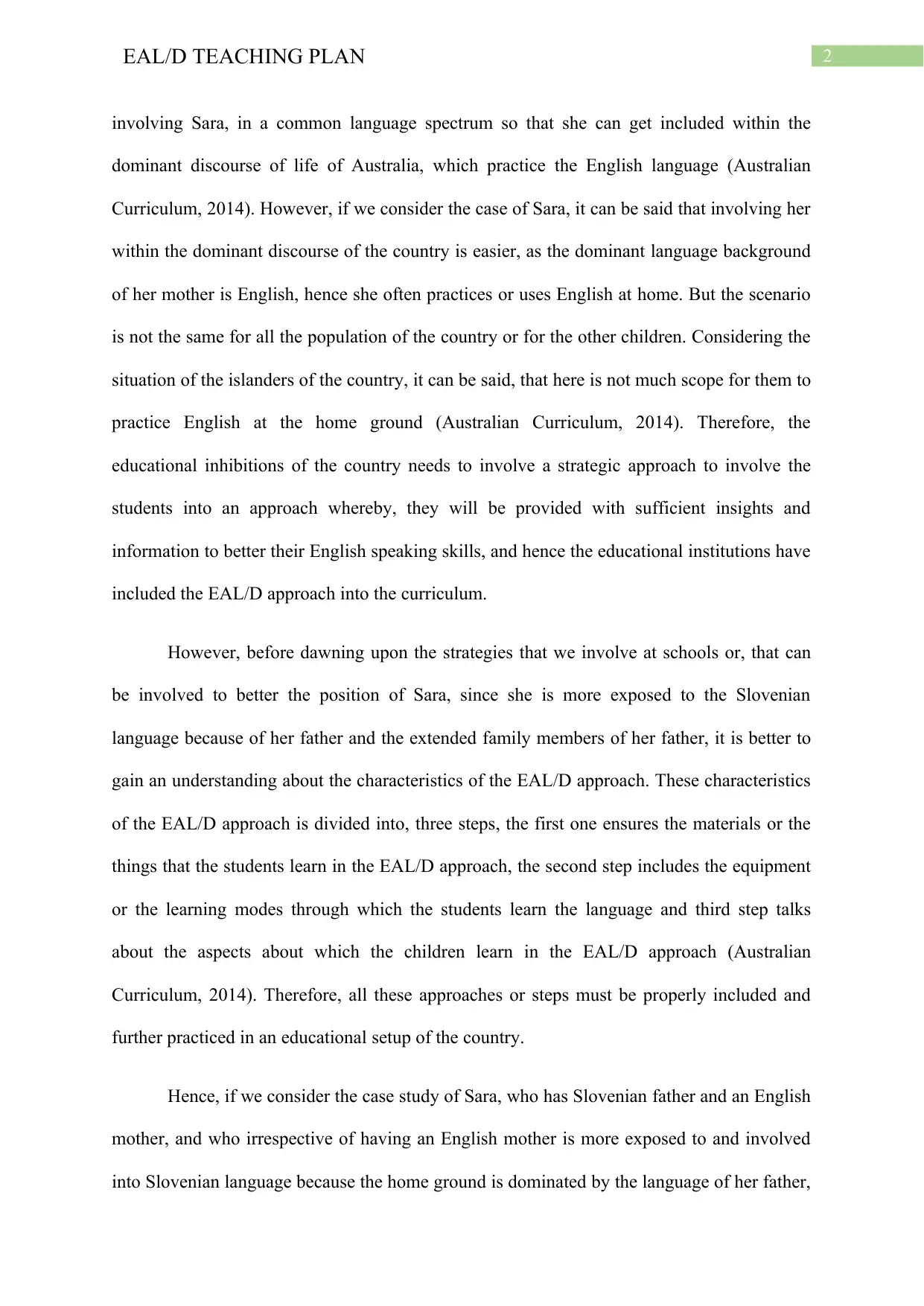
2EAL/D TEACHING PLAN
involving Sara, in a common language spectrum so that she can get included within the
dominant discourse of life of Australia, which practice the English language (Australian
Curriculum, 2014). However, if we consider the case of Sara, it can be said that involving her
within the dominant discourse of the country is easier, as the dominant language background
of her mother is English, hence she often practices or uses English at home. But the scenario
is not the same for all the population of the country or for the other children. Considering the
situation of the islanders of the country, it can be said, that here is not much scope for them to
practice English at the home ground (Australian Curriculum, 2014). Therefore, the
educational inhibitions of the country needs to involve a strategic approach to involve the
students into an approach whereby, they will be provided with sufficient insights and
information to better their English speaking skills, and hence the educational institutions have
included the EAL/D approach into the curriculum.
However, before dawning upon the strategies that we involve at schools or, that can
be involved to better the position of Sara, since she is more exposed to the Slovenian
language because of her father and the extended family members of her father, it is better to
gain an understanding about the characteristics of the EAL/D approach. These characteristics
of the EAL/D approach is divided into, three steps, the first one ensures the materials or the
things that the students learn in the EAL/D approach, the second step includes the equipment
or the learning modes through which the students learn the language and third step talks
about the aspects about which the children learn in the EAL/D approach (Australian
Curriculum, 2014). Therefore, all these approaches or steps must be properly included and
further practiced in an educational setup of the country.
Hence, if we consider the case study of Sara, who has Slovenian father and an English
mother, and who irrespective of having an English mother is more exposed to and involved
into Slovenian language because the home ground is dominated by the language of her father,
involving Sara, in a common language spectrum so that she can get included within the
dominant discourse of life of Australia, which practice the English language (Australian
Curriculum, 2014). However, if we consider the case of Sara, it can be said that involving her
within the dominant discourse of the country is easier, as the dominant language background
of her mother is English, hence she often practices or uses English at home. But the scenario
is not the same for all the population of the country or for the other children. Considering the
situation of the islanders of the country, it can be said, that here is not much scope for them to
practice English at the home ground (Australian Curriculum, 2014). Therefore, the
educational inhibitions of the country needs to involve a strategic approach to involve the
students into an approach whereby, they will be provided with sufficient insights and
information to better their English speaking skills, and hence the educational institutions have
included the EAL/D approach into the curriculum.
However, before dawning upon the strategies that we involve at schools or, that can
be involved to better the position of Sara, since she is more exposed to the Slovenian
language because of her father and the extended family members of her father, it is better to
gain an understanding about the characteristics of the EAL/D approach. These characteristics
of the EAL/D approach is divided into, three steps, the first one ensures the materials or the
things that the students learn in the EAL/D approach, the second step includes the equipment
or the learning modes through which the students learn the language and third step talks
about the aspects about which the children learn in the EAL/D approach (Australian
Curriculum, 2014). Therefore, all these approaches or steps must be properly included and
further practiced in an educational setup of the country.
Hence, if we consider the case study of Sara, who has Slovenian father and an English
mother, and who irrespective of having an English mother is more exposed to and involved
into Slovenian language because the home ground is dominated by the language of her father,
⊘ This is a preview!⊘
Do you want full access?
Subscribe today to unlock all pages.

Trusted by 1+ million students worldwide
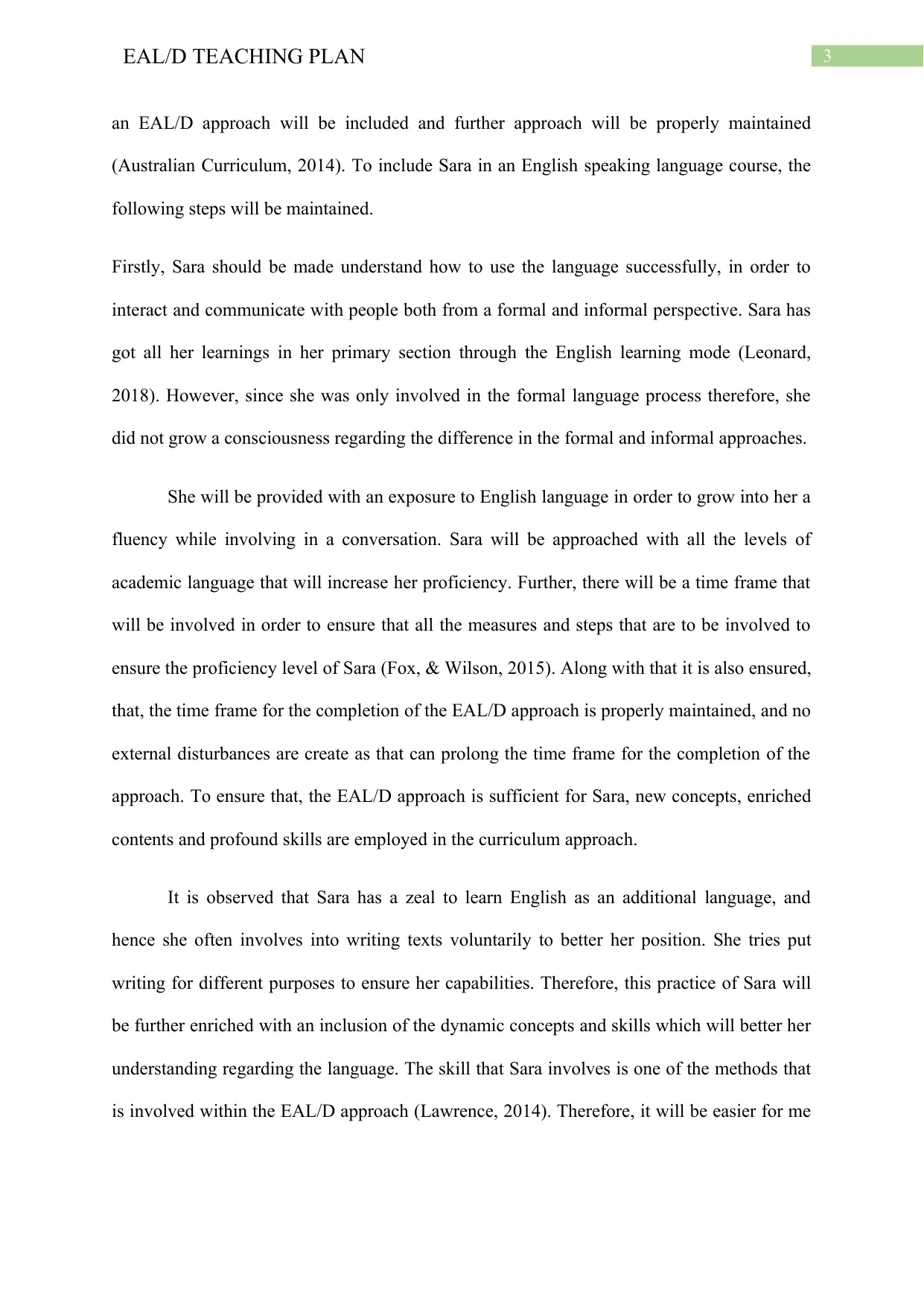
3EAL/D TEACHING PLAN
an EAL/D approach will be included and further approach will be properly maintained
(Australian Curriculum, 2014). To include Sara in an English speaking language course, the
following steps will be maintained.
Firstly, Sara should be made understand how to use the language successfully, in order to
interact and communicate with people both from a formal and informal perspective. Sara has
got all her learnings in her primary section through the English learning mode (Leonard,
2018). However, since she was only involved in the formal language process therefore, she
did not grow a consciousness regarding the difference in the formal and informal approaches.
She will be provided with an exposure to English language in order to grow into her a
fluency while involving in a conversation. Sara will be approached with all the levels of
academic language that will increase her proficiency. Further, there will be a time frame that
will be involved in order to ensure that all the measures and steps that are to be involved to
ensure the proficiency level of Sara (Fox, & Wilson, 2015). Along with that it is also ensured,
that, the time frame for the completion of the EAL/D approach is properly maintained, and no
external disturbances are create as that can prolong the time frame for the completion of the
approach. To ensure that, the EAL/D approach is sufficient for Sara, new concepts, enriched
contents and profound skills are employed in the curriculum approach.
It is observed that Sara has a zeal to learn English as an additional language, and
hence she often involves into writing texts voluntarily to better her position. She tries put
writing for different purposes to ensure her capabilities. Therefore, this practice of Sara will
be further enriched with an inclusion of the dynamic concepts and skills which will better her
understanding regarding the language. The skill that Sara involves is one of the methods that
is involved within the EAL/D approach (Lawrence, 2014). Therefore, it will be easier for me
an EAL/D approach will be included and further approach will be properly maintained
(Australian Curriculum, 2014). To include Sara in an English speaking language course, the
following steps will be maintained.
Firstly, Sara should be made understand how to use the language successfully, in order to
interact and communicate with people both from a formal and informal perspective. Sara has
got all her learnings in her primary section through the English learning mode (Leonard,
2018). However, since she was only involved in the formal language process therefore, she
did not grow a consciousness regarding the difference in the formal and informal approaches.
She will be provided with an exposure to English language in order to grow into her a
fluency while involving in a conversation. Sara will be approached with all the levels of
academic language that will increase her proficiency. Further, there will be a time frame that
will be involved in order to ensure that all the measures and steps that are to be involved to
ensure the proficiency level of Sara (Fox, & Wilson, 2015). Along with that it is also ensured,
that, the time frame for the completion of the EAL/D approach is properly maintained, and no
external disturbances are create as that can prolong the time frame for the completion of the
approach. To ensure that, the EAL/D approach is sufficient for Sara, new concepts, enriched
contents and profound skills are employed in the curriculum approach.
It is observed that Sara has a zeal to learn English as an additional language, and
hence she often involves into writing texts voluntarily to better her position. She tries put
writing for different purposes to ensure her capabilities. Therefore, this practice of Sara will
be further enriched with an inclusion of the dynamic concepts and skills which will better her
understanding regarding the language. The skill that Sara involves is one of the methods that
is involved within the EAL/D approach (Lawrence, 2014). Therefore, it will be easier for me
Paraphrase This Document
Need a fresh take? Get an instant paraphrase of this document with our AI Paraphraser
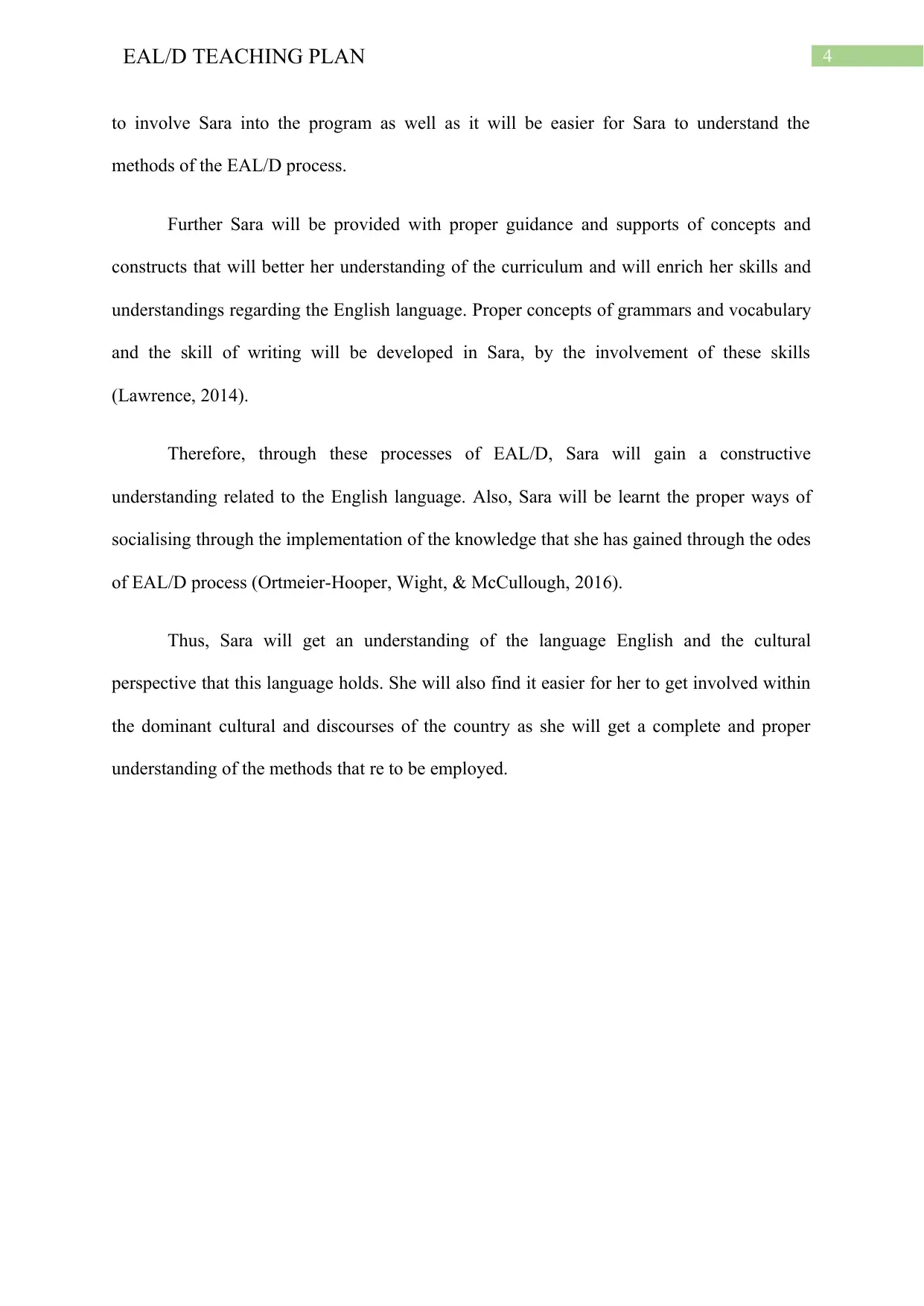
4EAL/D TEACHING PLAN
to involve Sara into the program as well as it will be easier for Sara to understand the
methods of the EAL/D process.
Further Sara will be provided with proper guidance and supports of concepts and
constructs that will better her understanding of the curriculum and will enrich her skills and
understandings regarding the English language. Proper concepts of grammars and vocabulary
and the skill of writing will be developed in Sara, by the involvement of these skills
(Lawrence, 2014).
Therefore, through these processes of EAL/D, Sara will gain a constructive
understanding related to the English language. Also, Sara will be learnt the proper ways of
socialising through the implementation of the knowledge that she has gained through the odes
of EAL/D process (Ortmeier-Hooper, Wight, & McCullough, 2016).
Thus, Sara will get an understanding of the language English and the cultural
perspective that this language holds. She will also find it easier for her to get involved within
the dominant cultural and discourses of the country as she will get a complete and proper
understanding of the methods that re to be employed.
to involve Sara into the program as well as it will be easier for Sara to understand the
methods of the EAL/D process.
Further Sara will be provided with proper guidance and supports of concepts and
constructs that will better her understanding of the curriculum and will enrich her skills and
understandings regarding the English language. Proper concepts of grammars and vocabulary
and the skill of writing will be developed in Sara, by the involvement of these skills
(Lawrence, 2014).
Therefore, through these processes of EAL/D, Sara will gain a constructive
understanding related to the English language. Also, Sara will be learnt the proper ways of
socialising through the implementation of the knowledge that she has gained through the odes
of EAL/D process (Ortmeier-Hooper, Wight, & McCullough, 2016).
Thus, Sara will get an understanding of the language English and the cultural
perspective that this language holds. She will also find it easier for her to get involved within
the dominant cultural and discourses of the country as she will get a complete and proper
understanding of the methods that re to be employed.
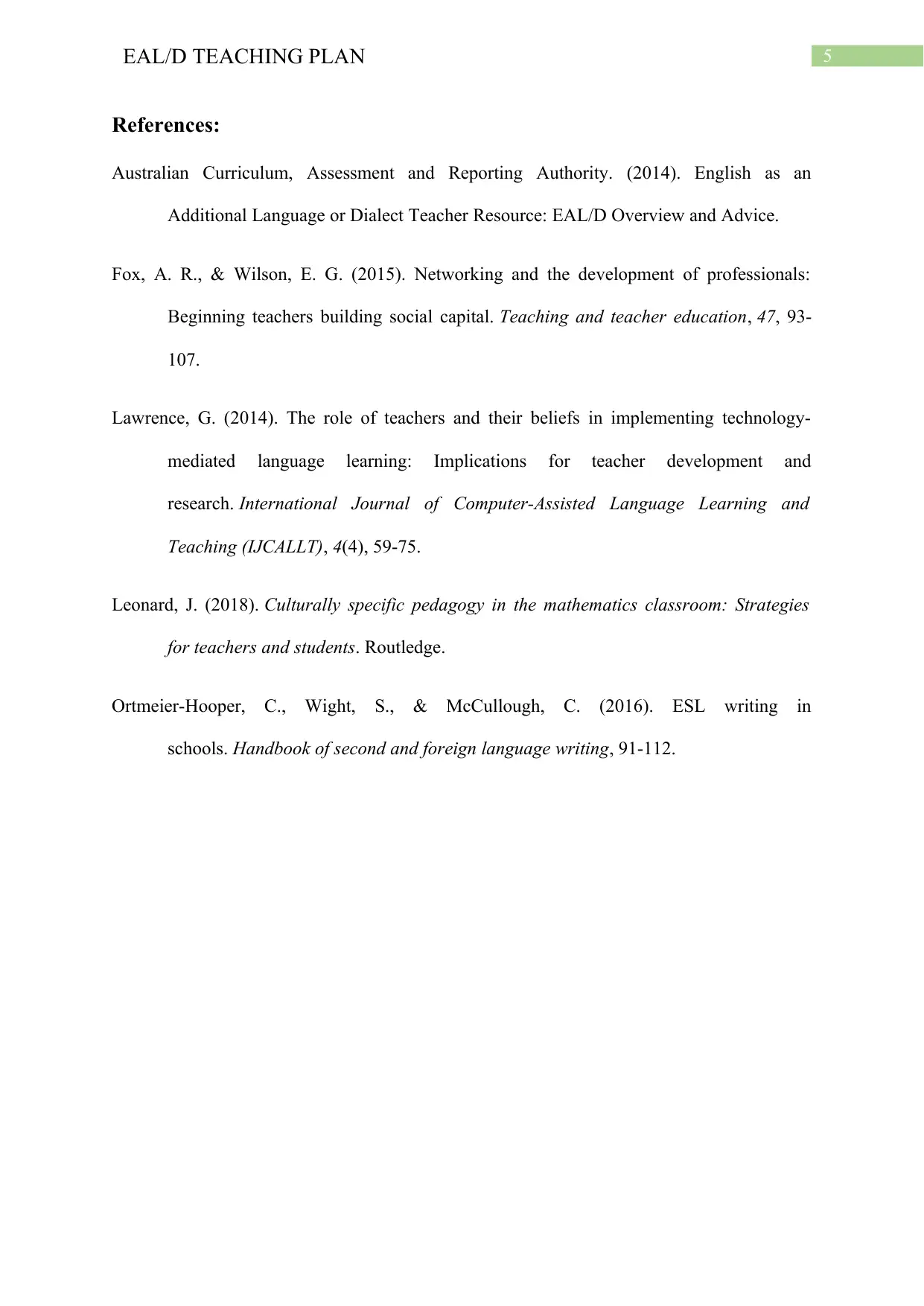
5EAL/D TEACHING PLAN
References:
Australian Curriculum, Assessment and Reporting Authority. (2014). English as an
Additional Language or Dialect Teacher Resource: EAL/D Overview and Advice.
Fox, A. R., & Wilson, E. G. (2015). Networking and the development of professionals:
Beginning teachers building social capital. Teaching and teacher education, 47, 93-
107.
Lawrence, G. (2014). The role of teachers and their beliefs in implementing technology-
mediated language learning: Implications for teacher development and
research. International Journal of Computer-Assisted Language Learning and
Teaching (IJCALLT), 4(4), 59-75.
Leonard, J. (2018). Culturally specific pedagogy in the mathematics classroom: Strategies
for teachers and students. Routledge.
Ortmeier-Hooper, C., Wight, S., & McCullough, C. (2016). ESL writing in
schools. Handbook of second and foreign language writing, 91-112.
References:
Australian Curriculum, Assessment and Reporting Authority. (2014). English as an
Additional Language or Dialect Teacher Resource: EAL/D Overview and Advice.
Fox, A. R., & Wilson, E. G. (2015). Networking and the development of professionals:
Beginning teachers building social capital. Teaching and teacher education, 47, 93-
107.
Lawrence, G. (2014). The role of teachers and their beliefs in implementing technology-
mediated language learning: Implications for teacher development and
research. International Journal of Computer-Assisted Language Learning and
Teaching (IJCALLT), 4(4), 59-75.
Leonard, J. (2018). Culturally specific pedagogy in the mathematics classroom: Strategies
for teachers and students. Routledge.
Ortmeier-Hooper, C., Wight, S., & McCullough, C. (2016). ESL writing in
schools. Handbook of second and foreign language writing, 91-112.
⊘ This is a preview!⊘
Do you want full access?
Subscribe today to unlock all pages.

Trusted by 1+ million students worldwide
1 out of 6
Related Documents
Your All-in-One AI-Powered Toolkit for Academic Success.
+13062052269
info@desklib.com
Available 24*7 on WhatsApp / Email
![[object Object]](/_next/static/media/star-bottom.7253800d.svg)
Unlock your academic potential
Copyright © 2020–2025 A2Z Services. All Rights Reserved. Developed and managed by ZUCOL.





